Fueling Fall Pollinators
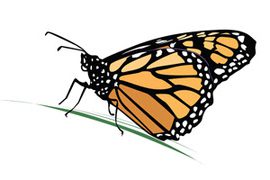 While many flowers are finished blooming by the fall, pollinators like bees, butterflies, moths, wasps and flower flies are still out foraging for food. This late group of pollinators also includes the monarch butterfly, which needs nectar to fuel its southward migration. Feed fall pollinators by providing late-blooming nectar resources.
While many flowers are finished blooming by the fall, pollinators like bees, butterflies, moths, wasps and flower flies are still out foraging for food. This late group of pollinators also includes the monarch butterfly, which needs nectar to fuel its southward migration. Feed fall pollinators by providing late-blooming nectar resources.
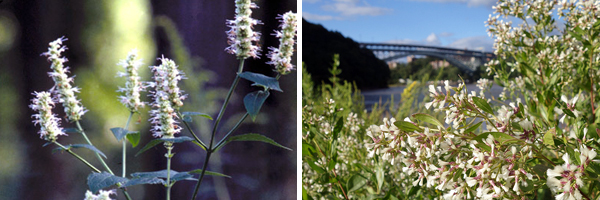
Left: Yellow giant hyssop; photo by Eugene van der Pijll. Right: Groundsel tree; photo by Steve Guttman, Flickr CC BY-NC-ND 2.0
Yellow giant hyssop (Agastache nepetoides)
Yellow giant hyssop is a tall perennial that can reach up to 7 feet in height. It has pale yellow spikes of flowers that are particularly attractive to bumblebees. It prefers to grow in part shade with well drained soils. A number of pollinators and predators (like parasitic wasps) are attracted to the plant. It is relatively deer resistant and is found throughout Maryland.
Groundsel tree (Baccharis halimifolia)
This native shrub grows up to 12 feet in height and can be found within the coastal plain. In late August-September, the shrub erupts into silvery, white flowers which are very attractive to migrating monarch butterflies. It prefers full sun in dry to moist soil conditions and grows best in slightly salty environments.
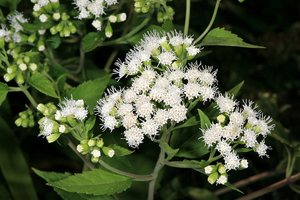
Boneset; photo by John Brandauer, Flickr CC BY-NC-ND 2.0
Boneset (Eupatorium perfoliatum)
Boneset can reach heights up to 5 feet and has clusters of wispy, white flowers that attract many pollinators. It blooms July through October and can withstand full sun or full shade. It thrives in moist-wet soil and can be found throughout Maryland.
White wood aster (Eurybia divaricata)
White wood aster is a native wildflower that blooms in late August through September. The plants emerge in late spring with heart-shaped leaves and will grow up to 2.5 feet tall. The flowers are loved by late season butterflies and the plant often is not disturbed by deer. It prefers part to full shade and well drained soils. It grows throughout Maryland and will self-seed and spread.
Cup plant (Silphium perfoliatum)
A 2008 study by Tuell et al. found that cup plant was one of the top three fall plants visited by native and managed bees. Bumblebees and sweat bees were the most attracted to cup plant blooms. Cup plant sports yellow flowers from July to October and grows up to 8 feet tall. It prefers dry to moist soil that is loamy and grows best in the Piedmont and Mountain regions of Maryland.
Blue-stemmed goldenrod (Solidago caesia) and zigzag goldenrod (Solidago flexicaulis)
Unlike many other goldenrods, these fall blooming goldenrods can tolerate part to full shade. Blue-stemmed goldenrod tends to prefer dry to mesic soil conditions, while zigzag goldenrod can tolerate more soil moisture. Both can grow up to 3 feet in height. Several species of native bees are oligoleges (specialist pollinators) and cannot reproduce without feeding on goldenrod. In addition, many goldenrod species contain high sugar concentrations in their nectar making it good fall fuel for pollinators. Blue-stemmed goldenrod can be found throughout Maryland, while zigzag goldenrod is found mostly in the Piedmont and Mountain regions of the state.
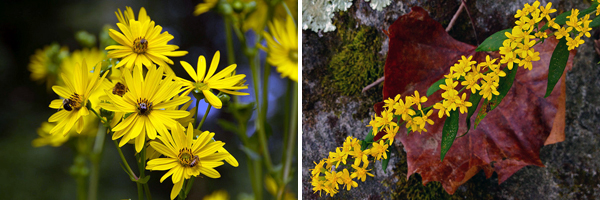
Left: Bees on cup plant; photo by rockerboo, Flickr CC BY-SA 2.0. Right: Blue-stemmed goldenrod; photo by Fritz Reynolds, Flickr CC BY-SA 2.0
White Heath Aster (Symphyotrichum ericoides)
This native aster has tiny white flowers and is often a garden volunteer. It can grow up to 2 feet in height, often clumps and can tolerate poor soil conditions. Interestingly enough, the nectar contains relatively high amino acid concentrations and sugar content which can help migrating monarchs reach their southern destinations and can help with future reproduction. Long-tongued bees, short-tongued bees, wasps, flies, butterflies, skippers, moths and beetles also benefit from white heath aster. It can mostly be found in the Piedmont and Mountain regions of Maryland.
New England aster (Symphyotrichum novae-angliae)
New England aster has brilliant blooms ranging in color from blue-purple to lavender-pink, with yellow-orange centers. The flowers can reach up to 6 feet in height and are attractive to bees and butterflies alike. The flowers provide sugar-rich nectar and high amino acid content which help with hungry butterflies, as well as those still in need of breeding. It grows in part to full sun in well-drained soils.
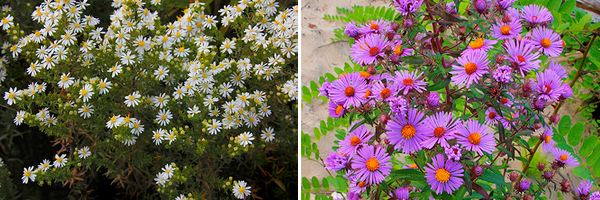
Left: White heath aster; photo by Dan Mullen, Flickr CC BY-NC-ND- 2.0. Right: New England aster; photo by Dan Mullen, Flickr CC BY-NC-ND-2.0
Sweet goldenrod (Solidago odora)
This licorice scented goldenrod grows up to 5 feet tall and blooms through October. It prefers full sun in dry to moist soils, but it sometimes also tolerates a little bit of shade. Like other goldenrods, this species is an insect magnet and attracts bees and butterflies alike.
Wrinkle-leaved goldenrod (Solidago rugosa)
This tall, tough goldenrod spreads in clumps and can be a bit aggressive. However, it’s a great plant for otherwise tough-to-grow locations. This goldenrod thrives in part to full sun in moist soils throughout the state. It has a high wildlife value, attracting bees, butterflies, beetles, lace bugs and more. It also produces flowers through November.
Author’s Note
Sincerely,
Kerry Wixted
Also in This Issue:
Backyard Wildlife Fun: Tracks!
Citizen Science: Bats, Butterflies and Moths
Fall Seed Sowing
Fueling Fall Pollinators
Native Plant Profile: Persimmon
Native Wildlife: Virginia Opossum
Want HabiChat delivered right to your inbox? Click here to sign up!


 1-888-373-7888
1-888-373-7888 233733
233733